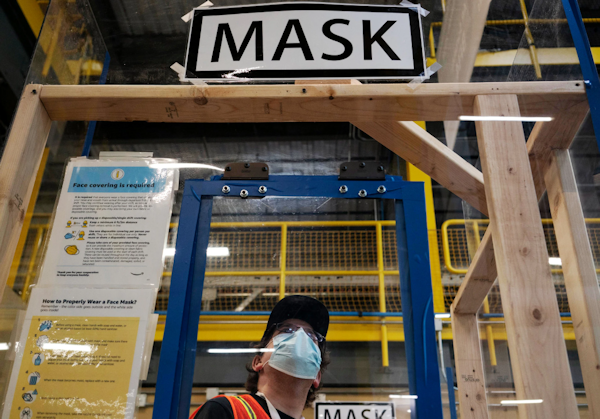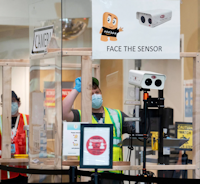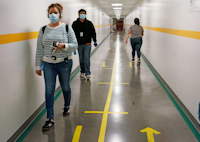Temps - Masks - Tests -
Internal Lab - Social Distancing
Amazon Invites NY Times in Warehouse To See Safety Measures
What It Looks Like Inside an Amazon Warehouse Now

A large sign indicates a station for handing out masks.
After months of being embattled over its response to
the coronavirus, Amazon is working to convince the public that its
workplaces — specifically, the warehouses where it stores everything from toys
to hand sanitizer — are safe during the pandemic.
 The giant internet retailer has started running
television ads that show that its warehouse and delivery employees have
masks and other protective gear. It has
pushed out segments to local news stations touting its safety improvements.
It has asked journalists to visit its warehouses to see for themselves.
The giant internet retailer has started running
television ads that show that its warehouse and delivery employees have
masks and other protective gear. It has
pushed out segments to local news stations touting its safety improvements.
It has asked journalists to visit its warehouses to see for themselves.
Amazon is spreading its safety message after a period that Jeff Bezos,
the company’s chief executive, has called “the hardest time we’ve ever faced.”
In hundreds of its facilities, workers became ill with Covid-19, and many blamed
the company. At the height of its crisis, one Amazon executive said he quit over
the firings of workers who had raised questions about workplace safety during
the pandemic.
While Amazon has rolled out safety changes, many workers and officials said
the measures were unevenly deployed and came too late.
But
in recent weeks, workers said, some conditions inside the warehouses have
improved. And the company, which was in emergency response mode in March and
April, has
resumed a more regular rhythm of business.

Amazon recently invited reporters into a fulfillment center in Kent, Wash., 20
miles south of Seattle, where the company is based. The New York Times agreed to
tour the facility to see the changes that Amazon and many workers around the
country had described.
Some high-traffic areas have changed. The human resources desk has put up walls
of plexiglass so people can still talk face to face, with a layer of separation.
There is tape throughout the warehouse marking out six-foot increments for
social distancing. Sanitizer stations are common; before they were rare.
The most dramatic transformation is at the building’s entryway, a wide
lobby area with tall turnstiles. Workers would previously pass through the
turnstiles and start their shift. Now when they arrive, they are channeled
past thermal cameras, manned by colleagues, to take their temperatures. At a
small stand enclosed in plexiglass, a worker stands with a stack of masks,
which are handed out using long tongs.
After workers pass through the temperature checks, they see a glass-walled room
that previously was used for training. The room is part of an Amazon pilot
program to test warehouse employees for Covid-19, part of the $4 billion
that the company has said it plans to spend in the next few months to respond to
the virus.&uuid=(email))
When workers enter the makeshift testing center, they scan their company badge.
They are handed, via forceps, a test kit for the virus. The small plastic
bag, which is marked with a biohazard symbol, contains a swab and test
tube-like container. Workers can go to one of several areas with tables to
follow instructions on how to administer the test. Then they seal their test
kit and place it into a green bin.
An employee of Concentra, a company that provides workplace health care, is on
hand to give the medical oversight needed for self-administered tests.
Amazon said more than 1,000 of the more than 3,000 workers at the facility have
been tested for the coronavirus.
Amazon has hired 175,000 temporary workers — including about 1,000 at this
warehouse alone — to stand in for employees who stayed home during the early
phase of the pandemic and to help meet demand that rivaled its peak holiday
season. Now the majority of those workers have been given permanent roles.
Emilie Deschamps, a worker who Amazon authorized to talk publicly, joined the
warehouse last October. She said the biggest change was not physical, but
rather, how Amazon had adjusted break times to stagger them and reduce
congestion, she said. The company also gave people extra time to wash
their hands, she said.
nytimes.com